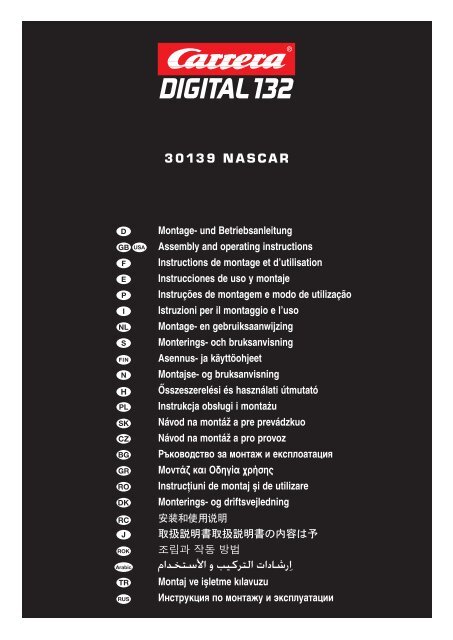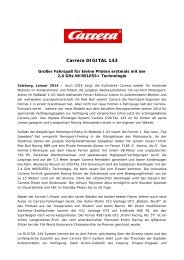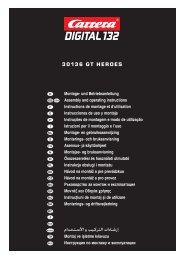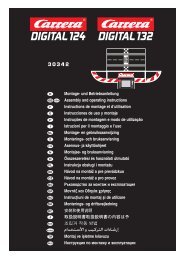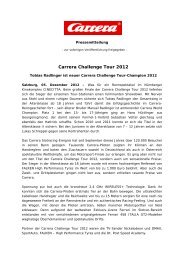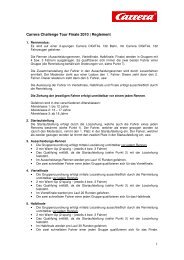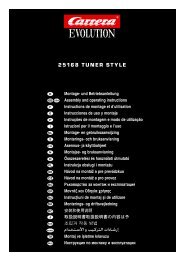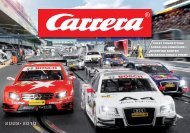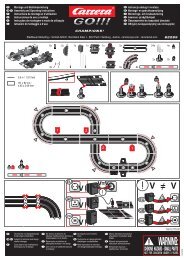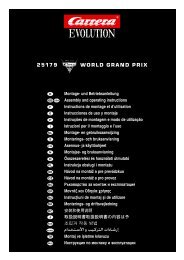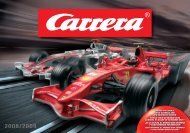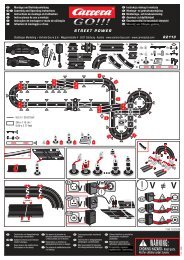You also want an ePaper? Increase the reach of your titles
YUMPU automatically turns print PDFs into web optimized ePapers that Google loves.
<strong>30139</strong> <strong>NASCAR</strong>
2<br />
<strong>30139</strong> <strong>NASCAR</strong><br />
F<br />
F<br />
D<br />
D<br />
F<br />
F<br />
<strong>30139</strong> + 20517 + 20601 + 20611<br />
E<br />
1x 2x 1x<br />
A<br />
12x<br />
B A<br />
E<br />
C<br />
1x<br />
D D<br />
E E<br />
E E<br />
D D<br />
D<br />
F<br />
D<br />
F F<br />
1x<br />
E E<br />
D<br />
F<br />
1x<br />
1x<br />
62x<br />
D D<br />
D<br />
F<br />
F<br />
D<br />
B 8x E<br />
C<br />
F<br />
F<br />
4x<br />
D<br />
12x<br />
Dodge and HEMI® are trademarks of Chrysler LLC.<br />
Dodge Charger, Dodge Viper and their trade dress are<br />
used under license by Stadlbauer Spiel- und Freizeitartikel<br />
GmbH. © Chrysler LLC 2009.<br />
General Motors Trademarks used under license to<br />
Stadlbauer Spiel- und Freizeitartikel GmbH.<br />
The stylized no. 31 is a trademark and the RCR checkered<br />
fl ag logo is a registered trademarks of RCR Enterprises,<br />
LLC. AT&T, and the AT&T logo are trademarks<br />
of AT&T Knowledge Ventures and/or AT&T affi liated<br />
companies used under license by AT&T Mobility LLC.<br />
JEFF BURTON and Jeff Burton’s autograph are trademarks<br />
of Jeff Burton Autosports, Inc. All trademarks,<br />
personal likenesses and the likeness of the no. 31 race<br />
car are used under license from their owners.<br />
<strong>NASCAR</strong>® is a registrated trademark of the National<br />
Association for Stock Car Auto Racing, Inc.<br />
© 2009 Richard Petty Motorsports. The stylized E with<br />
checkered fl ag® and 9® are registered trademarks of<br />
Richard Petty Motorsports, used under license. Kasey<br />
Kahne® name, likeness and signature are registered<br />
trademarks of Kasey Kahne Inc. licensed by Richard<br />
Petty Motorsports.<br />
F
8<br />
Table of contents<br />
Safety instructions 8<br />
Contents of package 8<br />
Technical advice for assembly 8<br />
Important Information 9<br />
Assembly instructions 9<br />
Guard Rails and Supports 9<br />
Electrical connection 9<br />
Car components 9<br />
Preparation of start 9<br />
Preparation of start and points function 10<br />
Race modes 10<br />
Light function on/off 10<br />
Operating 6 cars 10<br />
Coding/decoding of the cars to the according speed controller 10<br />
Autonomous Car function 10<br />
Pace Car function 10<br />
Setting basic speed 10<br />
Setting braking eff ect 10<br />
Setting fuel tank capacity 11<br />
Car programming from DIGITAL 132 to Evolution (analogue) 11<br />
Replacement of double sliding contact and guide keel 11<br />
Changing the rear axle/engine/engine block 11<br />
Maintenance and care 11<br />
Troubleshooting/Driving tips 11<br />
Technical specifi cations 11<br />
Welcome<br />
Welcome to the Team <strong>Carrera</strong>!<br />
These operating instructions contain important information regarding<br />
the assembly and operation of your <strong>Carrera</strong> DIGITAL 132 racetrack.<br />
Please read them carefully and keep them in a safe place afterwards.<br />
If you have any queries, please do not hesitate to contact<br />
our distributor or visit our websites:<br />
www.carrera-toys.com · www.carreraclub.com<br />
Please check the contents for completeness and possible transport<br />
damage. The packaging contains important information and should<br />
also be retained.<br />
We hope you will derive a lot of pleasure from your new <strong>Carrera</strong><br />
DIGITAL 132 track.<br />
1 Connecting track + Black Box<br />
2 Lane change section left input<br />
3 Lane change section left output<br />
4 Lane change section right input<br />
5 Lane change section right output<br />
6 Double lane change section input<br />
7 Double lane change section output<br />
8 Infrared sensor:<br />
The infrared sensor MUST be located on the switch that<br />
functions as the entry rail (dark diode).<br />
IMPORTANT:<br />
Driving direction from right to left only.<br />
2<br />
Safety instructions<br />
• WARNING! Not suitable for children under 36 months. Danger of<br />
suff ocation due to small parts which may be swallowed. Caution:<br />
risk of pinching caused by function.<br />
• WARNING!<br />
This toy contains magnets or magnetic components. Magnets attracting<br />
each other or a metallic object inside the human body may<br />
cause serious or fatal injuries. Seek medical attention immediately if<br />
magnets are swallowed or inhaled.<br />
• The transformer is not a toy! Do not short-circuit the transformer’s<br />
connections! Note to parents: Regularly inspect the transformer for<br />
damage to the cable, plug or housing! Only operate the toy with recommended<br />
transformers! The transformer may no longer be used<br />
if it is damaged! Only operate the racetrack with a transformer! If<br />
play is interrupted for longer periods, it is recommended to separate<br />
the transformer from the power supply. Do not open transformer or<br />
speed controller housings!<br />
Important note to parents:<br />
Transformers and power supply units are not suitable to be used as<br />
toys. The use of such products needs to be constantly supervised<br />
by the parents.<br />
• Regularly check the track and cars for damage to cables, plugs<br />
and housings! Replace defective parts.<br />
• The car racetrack is not suitable for outdoor operation or operation<br />
in wet locations! Keep away from liquids.<br />
• Do not place any metal parts onto the track to avoid short-circuits.<br />
Do not place the track in the immediate vicinity of delicate objects,<br />
as these could be damaged by cars hurled from the track.<br />
• Pull the plug before cleaning the racetrack! Only use a damp cloth<br />
for cleaning, no solvents or chemicals. When it is not in use, store<br />
the track in a dry and dust-protected location, preferably in the original<br />
cardboard box.<br />
• Do not operate race track at face- or eye-level – risk of injury due<br />
to cars being catapulted off the track.<br />
Note:<br />
The vehicle may only be operated again in a completely assembled<br />
condition. Assembly may only be carried out by an adult.<br />
Technical advice for assembly<br />
8<br />
3<br />
7<br />
6<br />
8<br />
1<br />
8<br />
4<br />
Contents of package<br />
1 Chevrolet® Impala SS #31Jeff Burton<br />
1 Dodge Charger #9 Kasey Kahne<br />
8 Standard straights<br />
12 High banked curves 3/30°<br />
1 Connecting section with Black Box<br />
1 <strong>Carrera</strong> DIGITAL 132 lane change section, right (2 track parts)<br />
1 <strong>Carrera</strong> DIGITAL 132 lane change section, left (2 track parts)<br />
8 <strong>Carrera</strong> DIGITAL 132 double lane change section<br />
(2 track parts)<br />
2 Speed controllers<br />
1 Transformer<br />
Guard rails<br />
Replacement contacts<br />
Shoulder end sections<br />
Instructions<br />
Track section bolts<br />
Track length: 32.28 ft. / 9,84 m<br />
Dimensions when assembled: 10.17 x 13.12 ft. / 400 x 310 cm<br />
5
EVOLUTION<br />
Important Information<br />
<strong>Carrera</strong> DIGITAL 132<br />
<strong>Carrera</strong> DIGITAL 132 EVOLUTION<br />
Please note that Evolution (analog system) and <strong>Carrera</strong> DIGIT-<br />
AL 132 (digital system) involve two separate and completely independent<br />
systems. We hereby expressly indicate that both systems<br />
must be kept separate when setting up the track, i.e. no connecting<br />
rail from Evolution may be used together with the connecting rail<br />
and Black Box of the <strong>Carrera</strong> DIGITAL 132, even if only one of the<br />
two connecting rails (Evolution connecting rail or <strong>Carrera</strong> DIGIT-<br />
AL 132 connecting rail and Black Box) is attached to the current<br />
supply. Furthermore, no other <strong>Carrera</strong> DIGITAL 132 components<br />
(switches, electronic lap counter, pit stop) may be built into an Evolution<br />
course, i.e. via analog operation.<br />
Non-compliance with the above information may result in damage<br />
or destruction of the respective <strong>Carrera</strong> DIGITAL 132 components.<br />
In this case no warranty may be claimed.<br />
Assembly instructions<br />
1 4<br />
2 3<br />
1 + 2 + 3 Before assembling please insert the connecting clips<br />
in the track as shown in fi gure 1 . Stick tracks together on a fl at<br />
base. Move the connecting clips according to fi gure 2 in direction<br />
of the arrow until they audibly snap in. The connecting clip may also<br />
be inserted later. The connecting clips can be removed into both<br />
directions by simply pressing down the clamped nose (see fi g. 3 ).<br />
4 Fastening: To fasten the track sections on a board, it is necessary<br />
to use the track section fasteners (Item no. 85209, not contained<br />
in the package).<br />
Note:<br />
Carpeting is not a suitable foundation on which to build the track because<br />
of static charging, formation of fl uff and ready infl ammability.<br />
Guard Rails and Supports<br />
1 2<br />
3 4<br />
1 Guard rails: Guard rail mounts are fi tted by tilting them upwards<br />
onto the verge of the track.<br />
2 + 3 Supporting raised sections: The shank of the ball pivot is<br />
to be inserted into the square slots provided on the underside of the<br />
track. The supports can be made higher by using the extensions.<br />
The pedestal of the supports can be screwed to a base if required<br />
(screws not included).<br />
4 Supporting steep curves:<br />
Slanting supports of the right height are provided to support steep<br />
curves. Fix the nonadjustable supports at the beginning and end of<br />
the curves. Insert the heads of the supports in the round slots of the<br />
underside of the track.<br />
1<br />
2<br />
Electrical connection<br />
1 Connect the transformer plug with the Black Box<br />
2 Connect the enclosed speed controllers to the Black Box<br />
Note: To avoid short-circuits and electrocution, the toy may not be<br />
connected using foreign devices, plugs, cables or other objects foreign<br />
to this toy. The <strong>Carrera</strong> DIGITAL 132 car racetrack only works<br />
properly with an original <strong>Carrera</strong> DIGITAL 132 transformer.<br />
The PC interface (PC Unit) may only be operated together with the<br />
original <strong>Carrera</strong> PC Unit.<br />
4<br />
13<br />
1<br />
8<br />
Car components<br />
9<br />
1 Body, spoiler<br />
2 Engine<br />
3 Support for engine block<br />
4 Tyres<br />
5 Rear axle<br />
6 Chassis<br />
7 Guide keel<br />
8 Double sliding contacts<br />
9 Front axle<br />
10 Central magnet unit<br />
11 Additional magnet unit<br />
12 Vehicle board with reversing switch<br />
13 Front light board<br />
14 Rear light board<br />
10<br />
7<br />
Note: vehicle construction depends on the model.<br />
12<br />
3<br />
4<br />
The designation of the individual parts may not be used as<br />
order numbers.<br />
4<br />
2<br />
5<br />
14<br />
Preparation of start<br />
1<br />
A<br />
B<br />
2<br />
b<br />
c<br />
b<br />
c<br />
a<br />
a<br />
3<br />
This <strong>Carrera</strong> DIGITAL 132 vehicle ideally matches the <strong>Carrera</strong> track<br />
system scale 1:24.<br />
1 Besides replacing the guide keel, the complete magnet units<br />
( A + B ) as well as the distance plates (a) beneath the magnets<br />
may be removed and added respectively. The more distance plates<br />
(a) and magnet units (b) are used the stronger the magnetic eff ect<br />
is on the track. As soon as a magnet is installed, the metal plate (c)<br />
has to be used. Depending on the car type it is advisable to remove<br />
or not to implement the spacing plate when using a <strong>Carrera</strong> crossing<br />
or high banked curve. With those track elements being used, slight<br />
driving noises may occur. These are caused by the cars´ scale authenticity<br />
and do not have any infl uence on a faultless operation.<br />
2 + 3 Optimally setting up the grinders:<br />
To ensure proper and continuous driving, slightly fan out the ends<br />
11<br />
6<br />
4<br />
9
of the contact brushes 2 and bend them towards the track as per<br />
fi g. 3 . Only the end of the contact brush should have contact to the<br />
track and may be cut off slightly in case of wear. Dust and abrasion<br />
should be removed from track material and sliding contacts from<br />
time to time.<br />
3<br />
10<br />
Preparation of start and<br />
points function<br />
1 2<br />
1 + 2 Make sure that the car’s guide keel is located inside the<br />
track slot and that the double sliding contact is in contact with the<br />
current carrying track.<br />
Place the cars onto the connecting track.<br />
3 When changing lanes, you must keep the button on the<br />
speed controller depressed until the car has passed the point.<br />
Race modes<br />
Training mode<br />
1. Switch on the Black Box (ON-OFF)<br />
2. After approx. 1 second the central LED will illuminate permanently<br />
and a brief acoustic signal will sound.<br />
3. Position the car/s on the connecting track<br />
4. In training mode, the track is released without signal from the<br />
traffi c light; you can start immediately<br />
Race mode<br />
1. Switch on the Black Box (ON-OFF)<br />
2. After approx. 1 second the central LED will illuminate permanently<br />
and a brief acoustic signal will sound.<br />
3. Afterwards, press the start button until all LEDs light up<br />
4. Position the car/s on the connecting track<br />
5. Press the start button again – the starting sequence will be initiated,<br />
the LEDs will illuminate and acoustic signals will sound.<br />
6. Once the traffi c light phase has expired (LEDs light up individually),<br />
the race is released<br />
7. False start: If a car’s speed controller is actuated during the traffi c<br />
light phase, this is rated as false start. The vehicle that has caused<br />
the false start will travel a short distance and the LED on the relevant<br />
vehicle or hand control will fl ash. The race is not released and<br />
the start has to be repeated.<br />
3 sec.<br />
STOP<br />
Light function on/off<br />
The car programmed to the speed controller will have to come to a<br />
stop for at least 3 seconds before the light can be switched on or off<br />
by the push of the lane-change-button.<br />
Operating 6 cars<br />
Plug speed controller extension set (item no. 30348) in connector 1<br />
of the Black Box. For next steps see section „Coding of cars to the<br />
according speed controller“.<br />
Coding/decoding of the cars to<br />
the according speed controller<br />
1 2<br />
2x CLICK<br />
3<br />
1<br />
2x CLICK<br />
Place car on the track, push lane-change-button twice fi g. 1 , lift car<br />
at the front, put car back again fi g. 2 , while car´s lights are fl ashing<br />
push lane-change-button twice fi g. 3 . Programming is confi rmed<br />
by a tone. All settings are saved until new programming is carried<br />
out.<br />
Autonomous Car function<br />
1 2<br />
4x CLICK<br />
SPEED<br />
+<br />
CLICK<br />
150<br />
100 200<br />
50 250<br />
Place car on the track, push lane-change-button twice, lift car at the<br />
front, put car back again (see coding/decoding fi g. 1 + 2). While<br />
car´s lights are fl ashing push lane-change-button 4 times fi g. 1 .<br />
Start car, push lane-change-button for requested speed fi g. 2 (irrespective<br />
of the car´s position). Autonomous car will drive at this<br />
speed automatically and consistently until its decoding.<br />
Decoding is eff ected by holding the car. For new coding see coding/<br />
decoding.<br />
0<br />
300<br />
Pace Car function<br />
Pit Stop 30346<br />
1 2<br />
6x CLICK<br />
SPEED<br />
+<br />
CLICK<br />
3 4<br />
150<br />
100 200<br />
50 250<br />
Place car on the track, push lane-change-button twice, lift car at the<br />
front, put car back again (see coding/decoding fi g. 1 + 2).<br />
While car´s lights are fl ashing push lane-change-button 6 times fi g.<br />
1 . Start car, push lane-change-button for requested speed fi g. 2<br />
(irrespective of the car´s position). Car will assume this speed consistently<br />
and will enter the next Pit Stop automatically fi g. 3 .<br />
Start Pace Car function:<br />
Start Pace Car by pushing the button at the Black Box fi g. 4 . After<br />
10 seconds each lane switch will change independently until the<br />
Pace Car enters the Pit Stop. Carry out car decoding (see point<br />
coding/decoding).<br />
0<br />
300<br />
Setting basic speed<br />
1 2 1 – 10<br />
1<br />
1 – 10<br />
(individually for one and/or several cars)<br />
1 Plug any speed controller in connector 1. Switch off Black Box,<br />
place car/s on the track, push lane-change-button and keep it<br />
pushed while Black Box is switched on again. Don´t release the<br />
lane-change-button until the 1st LED lights red. Levels are set by<br />
pushing lane-change-button. Confi rm speed by pressing the speed<br />
controller´s tappet (thumb) (=> middle LED will light).<br />
2<br />
1 LED on = low speed<br />
5 LEDs on = high speed<br />
Setting braking effect<br />
1 2 1 – 10<br />
2<br />
1 – 10<br />
(individually for one and/or several cars)<br />
1 Plug any speed controller in connector 2. Switch off Black Box,<br />
place car/s on the track, push lane-change-button and keep it<br />
pushed while Black Box is switched on again. Don´t release the<br />
lane-change-button until the 1st LED lights red. Levels are set by<br />
pushing lane-change-button. Confi rm braking eff ect by pressing<br />
speed controller´s tappet (thumb) (=> middle LED will light). Before<br />
the start return speed controller to the original connector!<br />
2<br />
1 LED on = low braking eff ect<br />
5 LEDs on = high braking eff ec
Setting fuel tank capacity<br />
Pit Stop 30346<br />
2 3 1 – 10<br />
3<br />
1<br />
1 – 10<br />
(individually for one and/or several cars)<br />
1 Activate fuelling function at the Black Box.<br />
2 Plug any speed controller in connector 3. Switch off Black Box,<br />
place car/s on the track, push lane-change-button and keep it<br />
pushed while Black Box is switched on again. Don´t release the<br />
lane-change-button until the 1st LED lights red. Fuel capacity is<br />
set by pushing lane-change-button. Confi rm by pressing speed<br />
controller´s tappet (=> middle LED will light).<br />
Before the start return speed controller to the original connector!<br />
3<br />
1 LED on = low fuel capacity<br />
5 LEDs on = full tank<br />
Refuelling:<br />
Depending on the fuel capacity the car´s lights start to fl ash after<br />
some time, the car slows down and might start to stutter. For refuelling<br />
enter the Pit Stop and release the speed controller´s tappet.<br />
(Fuelling amount depends on car´s standing time in the Pit Stop).<br />
a) Filling up: wait until car´s lights stop fl ashing.<br />
b) Partial refuelling: start while car´s lights still fl ash.<br />
c) Non-refuelling: car drives on at reduced speed.<br />
Car programming<br />
from DIGITAL 132<br />
to Evolution (analogue)<br />
Place car on the Evolution track and push speed controller´s tappet<br />
three times (thumb). Push the switch for changing the running direction<br />
acc. fi g. 1 . For <strong>Carrera</strong> DIGITAL 132 operation mode return<br />
the switch to original position.<br />
Replacement of double sliding<br />
contact and guide keel<br />
1<br />
2 a 2 b<br />
Advice:<br />
• It is recommended to always take out and change only one<br />
grinder.<br />
• Never pull the vehicle backwards, because the grinders could be<br />
damaged otherwise.<br />
1 Please carefully pull out the guide keel according to fi g. 1 .<br />
2 When changing the double contact brushes please take care<br />
that in stage one the upper contact brush 2 a is only pulled out<br />
partly and that in stage two the double contact brush can be pulled<br />
out completely with the contact brush 2 b . For inserting please<br />
proceed the same way.<br />
Changing the rear axle/<br />
engine/engine block<br />
1 2<br />
3<br />
4<br />
Changing the rear axle<br />
Loosen screw according to fi g. 1 . Take out the rear axle including<br />
the engine block with slight pressure and remove the axle carefully<br />
2 . Insert new axle, insert engine block while the nose clicks into<br />
the chassis and screw together 3 .<br />
Changing the engine/engine block<br />
Procedure as with changing the rear axle. However, the cable between<br />
engine and car board needs to be loosened or sticked together<br />
(see fi g. 4 ).<br />
Note:<br />
Having changed the engine the vehicle may not be operated until<br />
fully assembled.The engine may only be changed by adults.<br />
1<br />
2<br />
Maintenance and care<br />
To ensure a proper operation of the motor-racing circuit, all racetrack<br />
components should be regularly cleaned. Pull the plug prior to<br />
cleaning.<br />
1 Racetrack: Keep the track surface and track slots clean with a<br />
dry cloth. Do not use any solvents or chemicals for cleaning. When<br />
it is not in use, store the racetrack in a clean and dust-protected<br />
location, preferably in the original cardboard box.<br />
2 Car check: Clean axle and wheel bearings, pinion gears, gearwheels<br />
and bearings and lubricate using a resin- and acid-free<br />
grease. You can use a toothpick or similar as aid. Regularly check<br />
the condition of sliding contacts and tyres.<br />
Troubleshooting<br />
Driving tips<br />
Troubleshooting:<br />
In case of any malfunctions, please check the following:<br />
• Has the connection to the power supply been established correctly?<br />
• Have transformer and speed controllers been connected<br />
correctly?<br />
• Are the track connections faultless?<br />
• Are the racetrack and track slots clean and free of any foreign<br />
objects?<br />
• Are the sliding contacts in order and do they make contact with<br />
the track slot?<br />
• Are the cars correctly coded to the according speed controller?<br />
• The track‘s current feed will be switched off automatically for 5<br />
seconds, if there is an electrical short circuit: this will be notifi ed by<br />
audible and visual signals.<br />
• Are the cars placed on the track in running direction? In case of<br />
non-functioning push the running direction switch which is on the<br />
car´s bottom.<br />
Note:<br />
During operation small car parts as spoilers or mirrors may get off or<br />
brake due to being original detailed parts of the car model. To avoid<br />
this it is possible to remove them before operation.<br />
Driving technique:<br />
• You can drive fast along the straight track but you should brake<br />
before the curve and then accelerate again when coming out of the<br />
curve.<br />
• Do not fasten or block the vehicles when the motor is running:<br />
overheating or damage to the motor could result otherwise.<br />
Note: When using track systems which are not manufactured by<br />
<strong>Carrera</strong> the existing guide keel has to be replaced by the special<br />
guide keel (#85309). While using the <strong>Carrera</strong> crossing (#20587) or<br />
high banked curve 1/30° (#20574) slight driving noise might occur<br />
which is due to the full-scale genuineness and does not aff ect fl awless<br />
operation.<br />
All <strong>Carrera</strong> spare parts are available in the webshop:<br />
www.carrera-toys.com<br />
Delivery exclusively to Germany, Austria, Netherlands, Belgium and<br />
Luxembourg.<br />
Technical specifications<br />
Output voltage: Toy transformer<br />
14,8 V 51,8 VA<br />
This device is marked by “selective sort throught” symbol related to<br />
sort through domestic, electric and electronic, waste.<br />
This means the product must be treated by a specialized “sorting/<br />
collecting” system in accordance with European directive 2002/96/<br />
CE, to reduce the impact upon environment.<br />
For more precise information, please contact your local administration.<br />
Electronical product which are not going through special collecting,<br />
are potentially dangerous for environment and human health,<br />
because of dangerous substance.<br />
Output voltage: Toy transformer<br />
14,8 V 42,9 VA<br />
11


